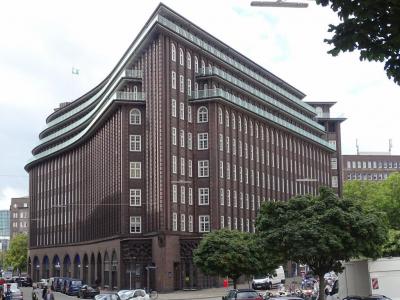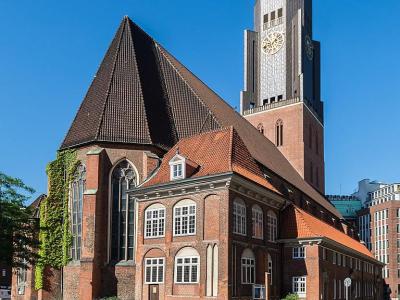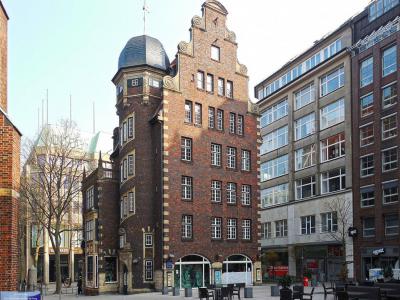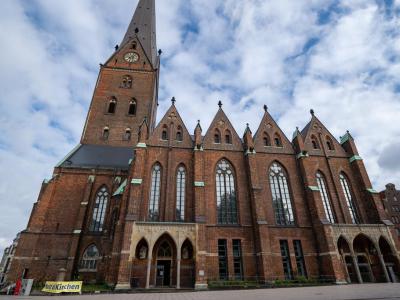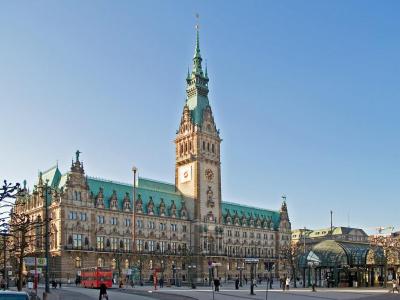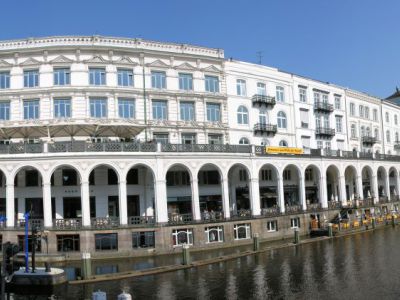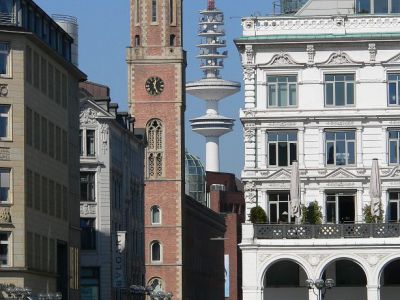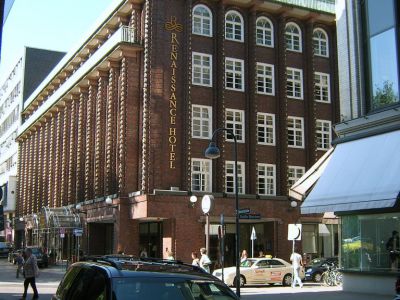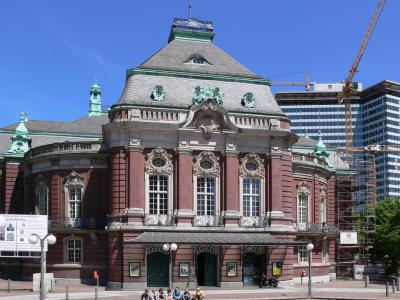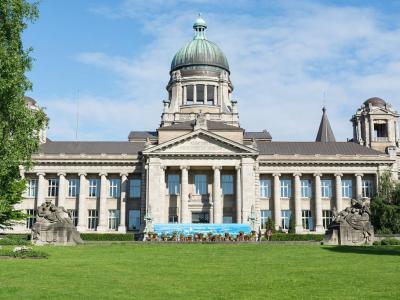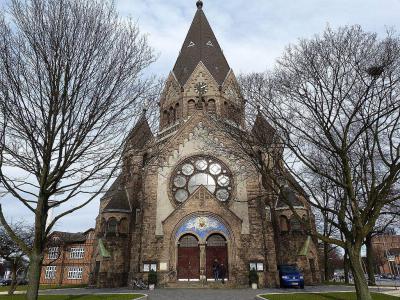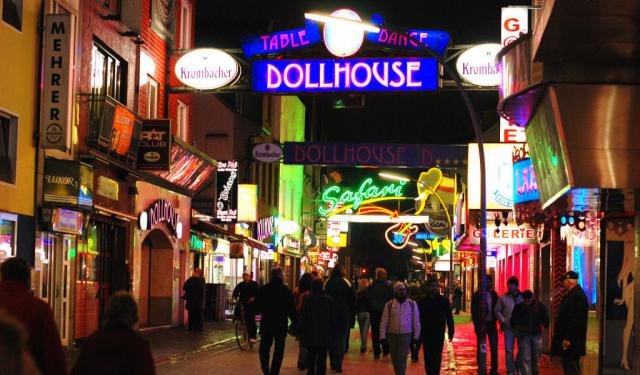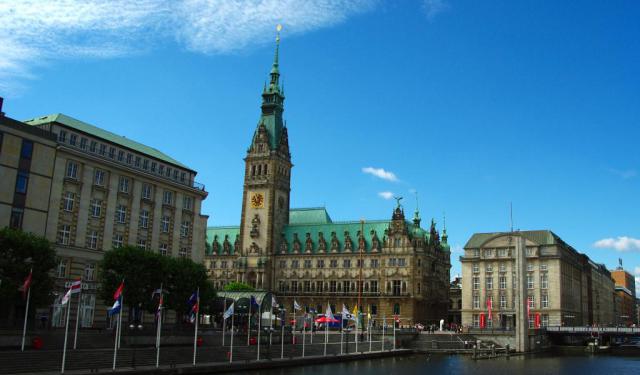Hamburg Historical Buildings (Self Guided), Hamburg
Hamburg, a city steeped in history and culture, boasts a wealth of remarkable historical buildings that tell the tale of its past. Harmonized with the recent extravagant urban development, these old structures make for unforgettable sights.
One iconic structure is the Chile House, renowned for its distinctive expressionist architecture, resembling a ship's prow. Another noteworthy site is the Saint Jacobi Church, an impressive Gothic-style church with a towering spire that has graced the city skyline since 1963.
The Pond House (Hulbe-Haus), characterized by its elegant façade and grandeur, is a symbol of Hamburg's commercial prosperity. Meanwhile, Saint Peter's Church stands as a testament to the city's religious heritage, showcasing intricate details and timeless beauty.
The Hamburg City Hall, or Hamburger Rathaus, is a striking Neo-Renaissance edifice that serves as the seat of local government and a symbol of civic pride. Nearby, the Alster Arcade (Alsterarkaden) invites visitors to stroll along its picturesque waterfront promenade, offering a glimpse into Hamburg's vibrant social scene.
The Old Post Office and Broschek House are architectural gems that reflect the city's past as a bustling trade hub, while the Laeisz Hall (Laeiszhalle) provides a majestic setting for musical performances and cultural events.
Finally, the Hanseatic Supreme Courthouse stands as a reminder of Hamburg's historical role in maritime trade and commerce, whereas the Church of Mercy offers solace and sanctuary to worshipers and visitors alike.
Hamburg's historical buildings are not just monuments of the past, but living testaments to the city's enduring spirit and legacy. As stewards of architectural heritage, it is our collective responsibility to celebrate these historical treasures for future generations to appreciate. With this self-guided tour, we ensure that Hamburg's architectural landmarks continue to inspire and enchant for years to come.
One iconic structure is the Chile House, renowned for its distinctive expressionist architecture, resembling a ship's prow. Another noteworthy site is the Saint Jacobi Church, an impressive Gothic-style church with a towering spire that has graced the city skyline since 1963.
The Pond House (Hulbe-Haus), characterized by its elegant façade and grandeur, is a symbol of Hamburg's commercial prosperity. Meanwhile, Saint Peter's Church stands as a testament to the city's religious heritage, showcasing intricate details and timeless beauty.
The Hamburg City Hall, or Hamburger Rathaus, is a striking Neo-Renaissance edifice that serves as the seat of local government and a symbol of civic pride. Nearby, the Alster Arcade (Alsterarkaden) invites visitors to stroll along its picturesque waterfront promenade, offering a glimpse into Hamburg's vibrant social scene.
The Old Post Office and Broschek House are architectural gems that reflect the city's past as a bustling trade hub, while the Laeisz Hall (Laeiszhalle) provides a majestic setting for musical performances and cultural events.
Finally, the Hanseatic Supreme Courthouse stands as a reminder of Hamburg's historical role in maritime trade and commerce, whereas the Church of Mercy offers solace and sanctuary to worshipers and visitors alike.
Hamburg's historical buildings are not just monuments of the past, but living testaments to the city's enduring spirit and legacy. As stewards of architectural heritage, it is our collective responsibility to celebrate these historical treasures for future generations to appreciate. With this self-guided tour, we ensure that Hamburg's architectural landmarks continue to inspire and enchant for years to come.
How it works: Download the app "GPSmyCity: Walks in 1K+ Cities" from Apple App Store or Google Play Store to your mobile phone or tablet. The app turns your mobile device into a personal tour guide and its built-in GPS navigation functions guide you from one tour stop to next. The app works offline, so no data plan is needed when traveling abroad.
Hamburg Historical Buildings Map
Guide Name: Hamburg Historical Buildings
Guide Location: Germany » Hamburg (See other walking tours in Hamburg)
Guide Type: Self-guided Walking Tour (Sightseeing)
# of Attractions: 11
Tour Duration: 2 Hour(s)
Travel Distance: 2.8 Km or 1.7 Miles
Author: Gloria
Sight(s) Featured in This Guide:
Guide Location: Germany » Hamburg (See other walking tours in Hamburg)
Guide Type: Self-guided Walking Tour (Sightseeing)
# of Attractions: 11
Tour Duration: 2 Hour(s)
Travel Distance: 2.8 Km or 1.7 Miles
Author: Gloria
Sight(s) Featured in This Guide:
- Chilehaus (Chile House)
- St. Jacobi Church
- Hulbe-Haus (Pond House)
- St. Peter's Church
- Hamburger Rathaus (Hamburg City Hall)
- Alsterarkaden (Alster Arcade)
- The Old Post Office
- Broschek House
- Laeiszhalle (Laeisz Hall)
- The Hanseatic Supreme Courthouse
- The Church of Mercy
1) Chilehaus (Chile House)
Chile House (Chilehaus) is a prominent architectural landmark located in Hamburg. This ten-story office building stands as a stunning example of Brick Expressionism, a popular architectural style in the 1920s. It was designed by the German architect Fritz Höger and completed in 1924 for the shipping magnate Henry B. Sloman, who earned his wealth through saltpeter trade with Chile, thus inspiring the building's name.
Covering an area of approximately 6,000 square meters (1.5 acres), Chile House is strategically placed in the Kontorhaus District. The building is renowned for its distinctive top resembling a ship's prow and its sharp-cornered façades. These features, combined with the vertical emphasis and recessed upper stories, impart a sense of lightness despite its substantial size.
The structure of Chile House is supported by reinforced concrete and constructed using about 4.8 million dark Oldenburg bricks. Given its proximity to the Elbe River and challenging terrain, the building is anchored on 16-meter-deep reinforced concrete pilings to ensure stability. It also features a specially sealed cellar and heating equipment housed in a floating caisson to prevent flood damage.
Artistic elements enhance the building's aesthetic, with sculptural details by Richard Kuöhl adorning the staircases and façade. Initially, Chilehaus featured paternoster lifts, which were modernized in 1991.
As part of the broader Kontorhaus District, Chile House was declared a UNESCO World Heritage Site in 2015, underscoring its cultural and historical significance. Today, it is owned by Union Investment Real Estate AG and hosts various tenants, including the Hamburg site of the Cervantes Institute.
Covering an area of approximately 6,000 square meters (1.5 acres), Chile House is strategically placed in the Kontorhaus District. The building is renowned for its distinctive top resembling a ship's prow and its sharp-cornered façades. These features, combined with the vertical emphasis and recessed upper stories, impart a sense of lightness despite its substantial size.
The structure of Chile House is supported by reinforced concrete and constructed using about 4.8 million dark Oldenburg bricks. Given its proximity to the Elbe River and challenging terrain, the building is anchored on 16-meter-deep reinforced concrete pilings to ensure stability. It also features a specially sealed cellar and heating equipment housed in a floating caisson to prevent flood damage.
Artistic elements enhance the building's aesthetic, with sculptural details by Richard Kuöhl adorning the staircases and façade. Initially, Chilehaus featured paternoster lifts, which were modernized in 1991.
As part of the broader Kontorhaus District, Chile House was declared a UNESCO World Heritage Site in 2015, underscoring its cultural and historical significance. Today, it is owned by Union Investment Real Estate AG and hosts various tenants, including the Hamburg site of the Cervantes Institute.
2) St. Jacobi Church
Saint Jacobi Church is one of the five Lutheran churches found in Hamburg city centre. It is located in the Neustadt quarter, close to Mönckebergstraße, one of the city’s main shopping streets. The first recorded mention of the church was in 1255, when it was listed as a small chapel outside of Hamburg’s city walls. It soon became a central part of the growing medieval city, and was replaced by a three naved hall church, similar to the nearby Saint Petri church. The fourth nave was added in the 15th century.
Saint Jacobi was destroyed by the extensive bombing of Hamburg during World War II. The church was rebuilt in 1963, in an unusual style featuring medieval design and a modern spire. Many of the church’s original features, including its 60-register baroque organ, survived the bombings and were installed in the new church. The organ, the largest in Northern Europe, can be heard at the church’s main service, held each Sunday morning.
Other medieval relics held within the modern church building include three altars dating from the 14th century, and the historic Ministers’ Room, featuring murals and landscape paintings by Johann Riesenberger. The stained glass windows, created by Charles Crodel, are a modern addition to this aesthetically pleasing place of worship.
Saint Jacobi was destroyed by the extensive bombing of Hamburg during World War II. The church was rebuilt in 1963, in an unusual style featuring medieval design and a modern spire. Many of the church’s original features, including its 60-register baroque organ, survived the bombings and were installed in the new church. The organ, the largest in Northern Europe, can be heard at the church’s main service, held each Sunday morning.
Other medieval relics held within the modern church building include three altars dating from the 14th century, and the historic Ministers’ Room, featuring murals and landscape paintings by Johann Riesenberger. The stained glass windows, created by Charles Crodel, are a modern addition to this aesthetically pleasing place of worship.
3) Hulbe-Haus (Pond House)
Hulbe Haus is a former art trading house located on Mönckeberg Street (Mönckebergstraße), one of Hamburg’s main shopping streets. Protruding into the street ahead of the adjacent, more contemporary buildings, it features a layered steeple topped with a golden cog. This is a symbol found across Hamburg and other Northern German port cities, like Hannover and Lübeck. Hulbe Haus is located in the center of Hamburg’s modern city center, close to Saint Petri Church and the Showroom Bischofsburg. It currently houses a department store on its lower floors, in keeping with its fashionable surroundings.
The red brick Hulbe Haus building dates from 1910, and was built by Henry Grell. Its façade is in the Dutch Renaissance style. The building is also notable for its proliferation of ‘Green Men’ carved into sandstone blocks around the façade. ‘Green Men’ is the collective name given to these carvings of mysterious bearded men with contorted faces. Closely resembling an image of God seen in many Christian works of art, they have been sighted in Thailand and China, and some carvings are believed to pre-date Christianity. Hulbe Haus is a must-see for hunters of ‘green men’ – there are over a dozen found on this ornate and unusual building.
The red brick Hulbe Haus building dates from 1910, and was built by Henry Grell. Its façade is in the Dutch Renaissance style. The building is also notable for its proliferation of ‘Green Men’ carved into sandstone blocks around the façade. ‘Green Men’ is the collective name given to these carvings of mysterious bearded men with contorted faces. Closely resembling an image of God seen in many Christian works of art, they have been sighted in Thailand and China, and some carvings are believed to pre-date Christianity. Hulbe Haus is a must-see for hunters of ‘green men’ – there are over a dozen found on this ornate and unusual building.
4) St. Peter's Church
A cathedral has existed on this site for centuries. Records indicate that Saint Peter's was built in the late 12th century before being rebuilt in the Gothic style during the 1300s. The most important Saint Peter's artifacts are the bronze lion-head door handles, which date to 1342.
Saint Peter's Church was heavily damaged in the Great Fire of 1842. However, many of the artworks, including the lion-head door handles, were saved.
After the fire, the church was rebuilt. The 132-meter-tall (433 foot) tower was completed in 1878.
Inside the church, visitors will find many important artworks. A 1460 Gothic mural shows the church's first bishop, Ansgar of Bremen. A statue created in the late 1400s also depicts Ansgar of Bremen. Two 17th century Gottfried Libalt paintings, Jacob's Dream and Christ's Birth are on display in the cathedral.
Another important painting is Christams 1813 in Saint Peter's. This painting depicts the Hamburg citizens locked in the church for refusing to feed Napolean's occupying troops.
Visitors are welcome to climb the 544 steps to the church's viewing platform. This is the highest viewing platform in the city, and guests can look out over the city center, Alster Lake, and the port.
Saint Peter's Church was heavily damaged in the Great Fire of 1842. However, many of the artworks, including the lion-head door handles, were saved.
After the fire, the church was rebuilt. The 132-meter-tall (433 foot) tower was completed in 1878.
Inside the church, visitors will find many important artworks. A 1460 Gothic mural shows the church's first bishop, Ansgar of Bremen. A statue created in the late 1400s also depicts Ansgar of Bremen. Two 17th century Gottfried Libalt paintings, Jacob's Dream and Christ's Birth are on display in the cathedral.
Another important painting is Christams 1813 in Saint Peter's. This painting depicts the Hamburg citizens locked in the church for refusing to feed Napolean's occupying troops.
Visitors are welcome to climb the 544 steps to the church's viewing platform. This is the highest viewing platform in the city, and guests can look out over the city center, Alster Lake, and the port.
5) Hamburger Rathaus (Hamburg City Hall) (must see)
The old city hall was destroyed in 1842, and it took until 1897 for the new city hall to be inaugurated. Hamburg City Hall's exterior has a Neo-Renaissance style. This massive building has an interior area of 17,000 square meters (182,986 square feet). The tower is 112 meters (367 feet) tall.
The new city hall was built to show Hamburg's immense wealth and prosperity. It is the seat of Hamburg's parliament, mayor, and senate. Heads of State such as Emperor Haile Salassie I, Mohammed Reza Pahlavi, and Queen Elizabeth II have been received in this impressive building.
The building's elaborate facade features 20 statues of emperors. The main entrance features a wrought iron gate. Don't miss the entrance hall's 16 sandstone pillars. Portraits adorning the pillars represent 68 Hamburg citizens. The imposing Sardinian marble staircase depicts the journey of life.
The Imperial Hall has a painted ceiling that depicts German merchant shipping, while pressed leather wall coverings decorate the walls. A phoenix representing Hamburg's recovery after the 1842 fire stands above the fireplace in Phoenix Hall.
The Senate chamber features a glass roof that fills the chamber with light and represents ancient open-air council meetings.
In the Grand Ballroom, visitors will find enormous paintings showing Hamburg's history from 800 to 1900. The impressive chandeliers have 278 lights each.
Hamburg City Hall's lobby is open to the public and is used for exhibitions and concerts. The balcony features a mosaic featuring the city's coat of arms and motto and depicts Hamburg's patron goddess Hammonia.
The courtyard features a fountain representing Hygieia, the Greek goddess of health and hygiene.
The new city hall was built to show Hamburg's immense wealth and prosperity. It is the seat of Hamburg's parliament, mayor, and senate. Heads of State such as Emperor Haile Salassie I, Mohammed Reza Pahlavi, and Queen Elizabeth II have been received in this impressive building.
The building's elaborate facade features 20 statues of emperors. The main entrance features a wrought iron gate. Don't miss the entrance hall's 16 sandstone pillars. Portraits adorning the pillars represent 68 Hamburg citizens. The imposing Sardinian marble staircase depicts the journey of life.
The Imperial Hall has a painted ceiling that depicts German merchant shipping, while pressed leather wall coverings decorate the walls. A phoenix representing Hamburg's recovery after the 1842 fire stands above the fireplace in Phoenix Hall.
The Senate chamber features a glass roof that fills the chamber with light and represents ancient open-air council meetings.
In the Grand Ballroom, visitors will find enormous paintings showing Hamburg's history from 800 to 1900. The impressive chandeliers have 278 lights each.
Hamburg City Hall's lobby is open to the public and is used for exhibitions and concerts. The balcony features a mosaic featuring the city's coat of arms and motto and depicts Hamburg's patron goddess Hammonia.
The courtyard features a fountain representing Hygieia, the Greek goddess of health and hygiene.
6) Alsterarkaden (Alster Arcade)
Alster Arcade (Alsterarkaden) in Hamburg is a picturesque shopping destination that combines architectural elegance with the serene ambiance of Hamburg's waterways. Designed by Alexis de Chateauneuf, a pioneering urban planner, the arcade was built in 1846 as part of the city's reconstruction following the Great Fire of 1842. The Alster Arcade, with its bright white arches reminiscent of Venice, offers a stunning reflection in the waters of the Inner Alster Lake, particularly enchanting at dusk when the city lights twinkle on the water.
The arcade's design features curved arches and Mediterranean charm, reflecting Chateauneuf's inspiration from his travels to Italy. This design not only revitalized the Jungfernstieg waterfront but also established an exclusive area for shopping, dining, and socializing amidst grandeur. The covered walkways provide shade and shelter, allowing for year-round enjoyment of the area, whether for a stroll or relaxing at one of the charming cafes along the canal.
Shopping at the Alster Arcade is a luxury experience with designer boutiques, exclusive jewelry stores, and high-end dining options. The Mellin Passage, the oldest shopping arcade in Hamburg connected to the Alster Arcade, offers unique finds such as antiques, rare books, and exquisite porcelain. Notably, a fire in 1989 led to the discovery of hidden Art Nouveau frescoes and stained glass in one of the Mellin Passage shops, adding an element of historical intrigue to the arcade.
The Alster Arcade is also home to cultural symbols like the white and black swans gliding across the Inner Alster Lake, a sight that holds significant cultural importance in Hamburg. The presence of these swans is intertwined with the city's identity, symbolizing Hamburg's enduring freedom and status as a Hanseatic city.
The arcade's design features curved arches and Mediterranean charm, reflecting Chateauneuf's inspiration from his travels to Italy. This design not only revitalized the Jungfernstieg waterfront but also established an exclusive area for shopping, dining, and socializing amidst grandeur. The covered walkways provide shade and shelter, allowing for year-round enjoyment of the area, whether for a stroll or relaxing at one of the charming cafes along the canal.
Shopping at the Alster Arcade is a luxury experience with designer boutiques, exclusive jewelry stores, and high-end dining options. The Mellin Passage, the oldest shopping arcade in Hamburg connected to the Alster Arcade, offers unique finds such as antiques, rare books, and exquisite porcelain. Notably, a fire in 1989 led to the discovery of hidden Art Nouveau frescoes and stained glass in one of the Mellin Passage shops, adding an element of historical intrigue to the arcade.
The Alster Arcade is also home to cultural symbols like the white and black swans gliding across the Inner Alster Lake, a sight that holds significant cultural importance in Hamburg. The presence of these swans is intertwined with the city's identity, symbolizing Hamburg's enduring freedom and status as a Hanseatic city.
7) The Old Post Office
The Old Post Office is situated immediately next to the Hamburger Rathaus, in the Neustadt area of the city which houses many of Hamburg’s civic buildings. It was designed by Alexis de Chateauneuf, a German architect tasked with creating and restoring several buildings following the Great Fire of Hamburg in 1842. The ground floor of the former Post Office building bears a series of arches similar to the nearby Alsterarkaden, also designed by de Chateauneuf. Opened in 1847, the building was later converted into a shopping arcade, which it remains to this day.
The Old Post Office building, rather than a reconstruction of a damaged or destroyed landmark, was created by the architect to solve a problem particular to Hamburg. The city covers a large area, divided by rivers and lakes, and faced many challenges in setting up basic networks, including transportation, sanitation, and a postal service. In the 19th century Hamburg, four different regional companies delivered posts around the city – Hamburg’s city post office, Thurn & Taxi, the Royal Hannover post office, and the Swedish postal service. This building, with four separate entrances and extensive mail transfer facilities, began the process of centralizing postal services in this growing city-state.
The Old Post Office building, rather than a reconstruction of a damaged or destroyed landmark, was created by the architect to solve a problem particular to Hamburg. The city covers a large area, divided by rivers and lakes, and faced many challenges in setting up basic networks, including transportation, sanitation, and a postal service. In the 19th century Hamburg, four different regional companies delivered posts around the city – Hamburg’s city post office, Thurn & Taxi, the Royal Hannover post office, and the Swedish postal service. This building, with four separate entrances and extensive mail transfer facilities, began the process of centralizing postal services in this growing city-state.
8) Broschek House
Broschek Haus is located on the corner of Heuberg and Große Bleichen, in the historic Neustadt quarter of Hamburg. Built in 1925 and 1926 as headquarters for the Broschek publishing company, it was designed by renowned architect Fritz Hoger. An example of the Expressionist architectural movement popular in 1920s Germany, the building has an unusual stepped shape, with the upper three floors set back from the lower half of the building. It was initially supposed to be topped with a steeple – one of many extravagant features suggested by Hoger that were ultimately declined by the Broschek directors.
The building is now a luxury hotel, well placed for most of the city’s sights. It served as a publishing house until World War 2, whilst the national newspaper Die Welt was produced here under British occupation in 1946. Whilst the architect’s original plan was never fully realized, there are many interesting features which make Broschek Haus stand out from the many other grand office buildings in central Hamburg. There are gold triangles jutting out from the dark red brick work – when the sun catches the building’s exterior, they give the impression of sails glinting in the sunlight. There is also a small gold statue of the architect, hidden on a corner of this large office block.
The building is now a luxury hotel, well placed for most of the city’s sights. It served as a publishing house until World War 2, whilst the national newspaper Die Welt was produced here under British occupation in 1946. Whilst the architect’s original plan was never fully realized, there are many interesting features which make Broschek Haus stand out from the many other grand office buildings in central Hamburg. There are gold triangles jutting out from the dark red brick work – when the sun catches the building’s exterior, they give the impression of sails glinting in the sunlight. There is also a small gold statue of the architect, hidden on a corner of this large office block.
9) Laeiszhalle (Laeisz Hall)
The Laeisz Hall is Hamburg’s most popular concert hall, and regularly hosts internationally renowned classical performers and recitals. It is located on Johannes Brahms Platz, an elegant city square named after one of history’s finest composers, who was born in Hamburg. A striking neo-Baroque building, it hosts the Hamburg State Opera and Hamburg Music Festival each year. Formerly known as the Musikhalle Hamburg, it is named after F. Laeisz, a shipping company which founded the venue. The hall was planned by local architect Martin Haller, a lifelong Hamburger who also designed the Rathaus building, and became a member of parliament in the city.
First opened in 1908, the Laeiszhalle is the premier classical music venue in a city with a rich musical heritage, from Brahms to the Beatles, who spent many years living in the city. It will soon be joined by the Elbe Philharmonic Hall, a new venue due to open in the HafenCity in 2015. Both venues will work in partnership to attract the most stellar names in the classical field to Hamburg. It wouldn’t be the first time – Richard Strauss, Sergei Prokofiev and Igor Stravinsky have all performed or conducted their own works within this historic concert hall.
First opened in 1908, the Laeiszhalle is the premier classical music venue in a city with a rich musical heritage, from Brahms to the Beatles, who spent many years living in the city. It will soon be joined by the Elbe Philharmonic Hall, a new venue due to open in the HafenCity in 2015. Both venues will work in partnership to attract the most stellar names in the classical field to Hamburg. It wouldn’t be the first time – Richard Strauss, Sergei Prokofiev and Igor Stravinsky have all performed or conducted their own works within this historic concert hall.
10) The Hanseatic Supreme Courthouse
The Hanseatic Higher Regional Court (HansOLG) in Hamburg, situated on Sieveking Square in the Saint Pauli quarter, stands as a historic and architecturally significant judicial edifice. Named after Ernst Friedrich Sieveking, its first president, the court was initially established on October 1, 1879, as the Court of Appeal. It served the Free Imperial Cities of Bremen, Hamburg, and Lübeck, inheriting the jurisdiction previously held by the Higher Court of Appeal of the Four Free Cities in Lübeck.
The court's central building, completed in 1912, is part of a larger judicial complex on Sieveking Square. This complex also includes the Civil Law Court and the Criminal Law Court, both noteworthy for their early 20th-century architectural styles and the use of materials like sandstone, yellow brick, and red brick. These buildings, designed by architects Lundt & Kallmorgen, showcase the era's reverence for the law through their grandeur and imposing structures, particularly the 52-meter-high dome of the Higher Regional Court building.
The Higher Regional Court itself is an exemplary piece of Neoclassical architecture. It harmonizes with the two adjacent larger buildings through its design features, including slender sand-lime brick columns and twin towers that accentuate its corners. The interior of the court is equally magnificent, with a spacious entrance hall, a plenary hall largely adorned with marble, an oak-paneled library, and four elaborately designed meeting rooms.
The entire complex is listed as a historical structure, embodying both architectural and historical significance. The facade of the court building is notably inscribed with a definition of law by the Roman jurist Publius Iuventius Celsus: "Law is the Art of the Good and the Equitable", highlighting the philosophical foundations upon which the court was established. Together, these buildings not only serve as functional spaces for legal proceedings but also stand as monuments to the judicial history and architectural heritage of Hamburg.
The court's central building, completed in 1912, is part of a larger judicial complex on Sieveking Square. This complex also includes the Civil Law Court and the Criminal Law Court, both noteworthy for their early 20th-century architectural styles and the use of materials like sandstone, yellow brick, and red brick. These buildings, designed by architects Lundt & Kallmorgen, showcase the era's reverence for the law through their grandeur and imposing structures, particularly the 52-meter-high dome of the Higher Regional Court building.
The Higher Regional Court itself is an exemplary piece of Neoclassical architecture. It harmonizes with the two adjacent larger buildings through its design features, including slender sand-lime brick columns and twin towers that accentuate its corners. The interior of the court is equally magnificent, with a spacious entrance hall, a plenary hall largely adorned with marble, an oak-paneled library, and four elaborately designed meeting rooms.
The entire complex is listed as a historical structure, embodying both architectural and historical significance. The facade of the court building is notably inscribed with a definition of law by the Roman jurist Publius Iuventius Celsus: "Law is the Art of the Good and the Equitable", highlighting the philosophical foundations upon which the court was established. Together, these buildings not only serve as functional spaces for legal proceedings but also stand as monuments to the judicial history and architectural heritage of Hamburg.
11) The Church of Mercy
The Church of Mercy (Gnadenkirche) in Hamburg offers a unique blend of historical and architectural significance nestled within the city's bustling urban environment. Located on Holstenglacis Road, it marks the northern boundary of the picturesque Planten un Blomen public park. Built in 1907, the church is an exemplary model of neo-Roman style architecture, a style that showcases the aesthetic preferences before the 20th century, particularly among Protestant ecclesiastical buildings.
The church is most distinguished by its central steeple, topped with a diamond-shaped roof, which adds a notable landmark to the area. The interior of the Church of Mercy is relatively modest yet strikingly arranged; the hall is designed around the altar and pulpit, creating a theatrical ambiance that enhances the spiritual and communal experience. This layout is typical of Reformation-era ecclesiastical architecture, aimed at focusing congregational attention on the sermon and liturgical activities.
Situated in Hamburg's Saint Pauli district, an area known for its bohemian vibe, the church is unfortunately subjected to the constant hum of traffic from nearby streets. Despite this, its location is strategic, being close to significant city attractions like the Reeperbahn and Landungsbrücken.
Hamburg, traditionally a Catholic stronghold, embraced the Reformation comprehensively, leading to a predominance of Protestant and Lutheran churches in the city center. The Church of Mercy is one of these Protestant establishments and draws its name from an image of Mary located within its walls, believed to bestow mercy upon its viewers. This has made the church a pilgrimage site for those seeking solace and grace, characteristic of "churches of mercy" or grace chapels throughout the region.
The Church of Mercy stands as a spiritual sanctuary and a historical relic that continues to serve the spiritual needs of its community amidst the modern challenges of urban noise and secular surroundings.
The church is most distinguished by its central steeple, topped with a diamond-shaped roof, which adds a notable landmark to the area. The interior of the Church of Mercy is relatively modest yet strikingly arranged; the hall is designed around the altar and pulpit, creating a theatrical ambiance that enhances the spiritual and communal experience. This layout is typical of Reformation-era ecclesiastical architecture, aimed at focusing congregational attention on the sermon and liturgical activities.
Situated in Hamburg's Saint Pauli district, an area known for its bohemian vibe, the church is unfortunately subjected to the constant hum of traffic from nearby streets. Despite this, its location is strategic, being close to significant city attractions like the Reeperbahn and Landungsbrücken.
Hamburg, traditionally a Catholic stronghold, embraced the Reformation comprehensively, leading to a predominance of Protestant and Lutheran churches in the city center. The Church of Mercy is one of these Protestant establishments and draws its name from an image of Mary located within its walls, believed to bestow mercy upon its viewers. This has made the church a pilgrimage site for those seeking solace and grace, characteristic of "churches of mercy" or grace chapels throughout the region.
The Church of Mercy stands as a spiritual sanctuary and a historical relic that continues to serve the spiritual needs of its community amidst the modern challenges of urban noise and secular surroundings.
Walking Tours in Hamburg, Germany
Create Your Own Walk in Hamburg
Creating your own self-guided walk in Hamburg is easy and fun. Choose the city attractions that you want to see and a walk route map will be created just for you. You can even set your hotel as the start point of the walk.
St. Pauli and Red-light District Walking Tour
St. Pauli is a vibrant quarter in Hamburg. It is home to museums, churches, waterfront buildings, and the famous Red Light District. During the 19th century, many sailors would arrive in Hamburg's busy port and immediately look for ways to spend their wages. St. Pauli obliged with entertainment, bars, and strip clubs. Today, the entertainment tradition continues.
The Old Elbe Tunnel is a... view more
Tour Duration: 2 Hour(s)
Travel Distance: 3.4 Km or 2.1 Miles
The Old Elbe Tunnel is a... view more
Tour Duration: 2 Hour(s)
Travel Distance: 3.4 Km or 2.1 Miles
Famous Brewpubs in Hamburg
Hamburg, true to the German tradition, is famous for its beer. So much so, in fact, that several local beer brands are considered among the best in the country. These renowned brewpubs are the ideal place where you can taste genuine local beer and have fun while in Hamburg.
One such establishment is the Hofbräu on Alster Restaurant, located near the picturesque Alster Lake. Here, patrons can... view more
Tour Duration: 1 Hour(s)
Travel Distance: 1.9 Km or 1.2 Miles
One such establishment is the Hofbräu on Alster Restaurant, located near the picturesque Alster Lake. Here, patrons can... view more
Tour Duration: 1 Hour(s)
Travel Distance: 1.9 Km or 1.2 Miles
Hamburg Introduction Walking Tour
Hamburg is one of Germany's largest cities, second only to Berlin. It is also Europe's third-largest port. The city has a population of over 1.8 million, and the metropolitan area is home to over five million people. Its official name is the Free and Hanseatic City of Hamburg. This name reflects its historical membership in the medieval Hanseatic League and one of the Holy Roman... view more
Tour Duration: 2 Hour(s)
Travel Distance: 3.1 Km or 1.9 Miles
Tour Duration: 2 Hour(s)
Travel Distance: 3.1 Km or 1.9 Miles
The Most Popular Cities
/ view all



